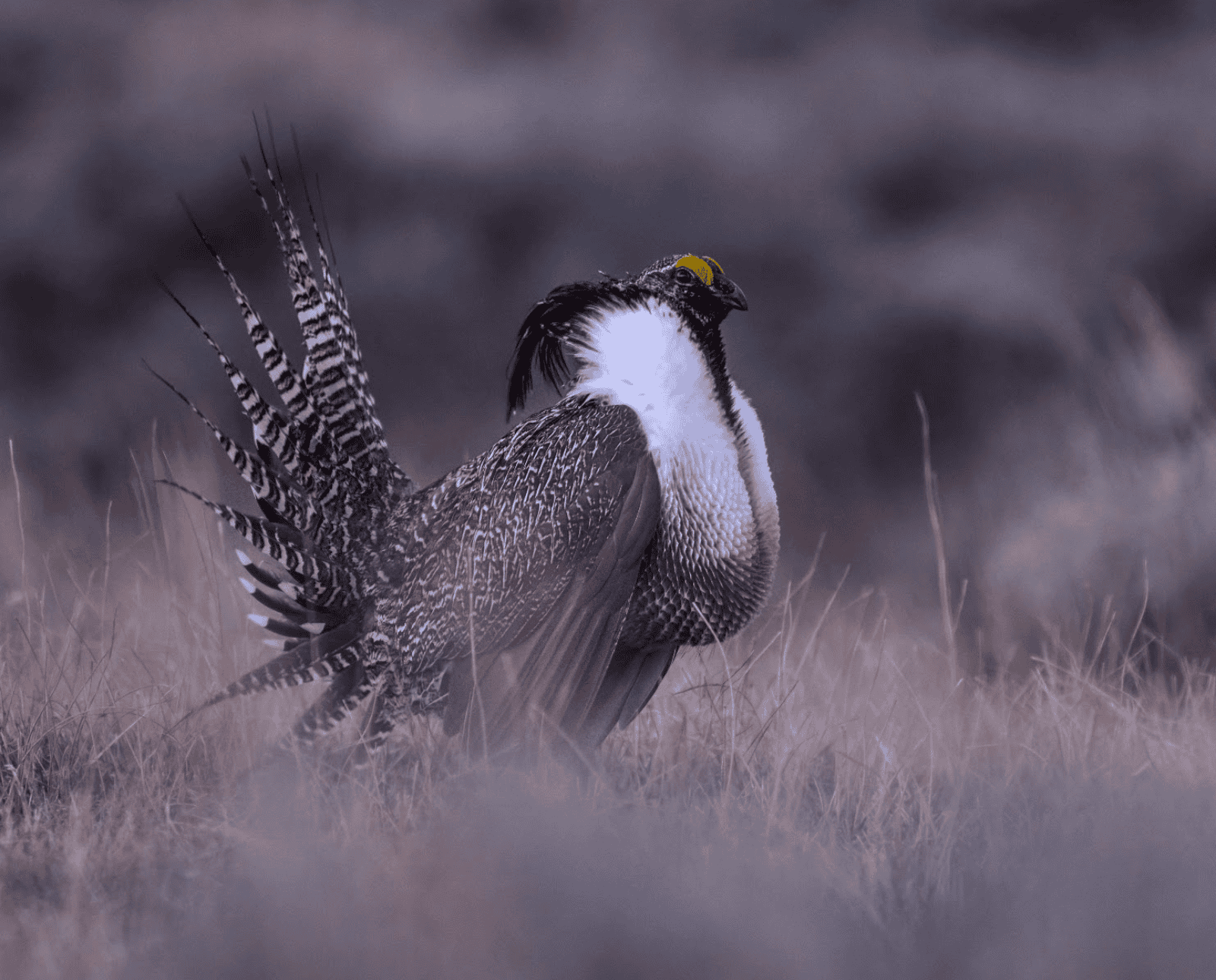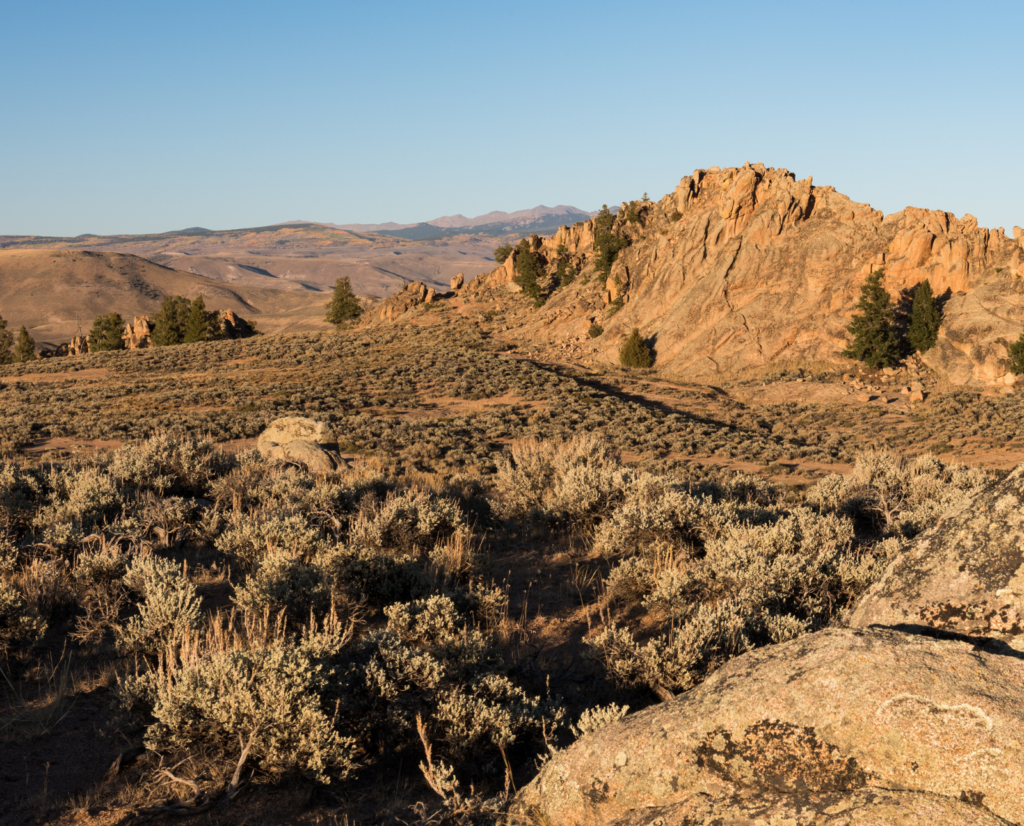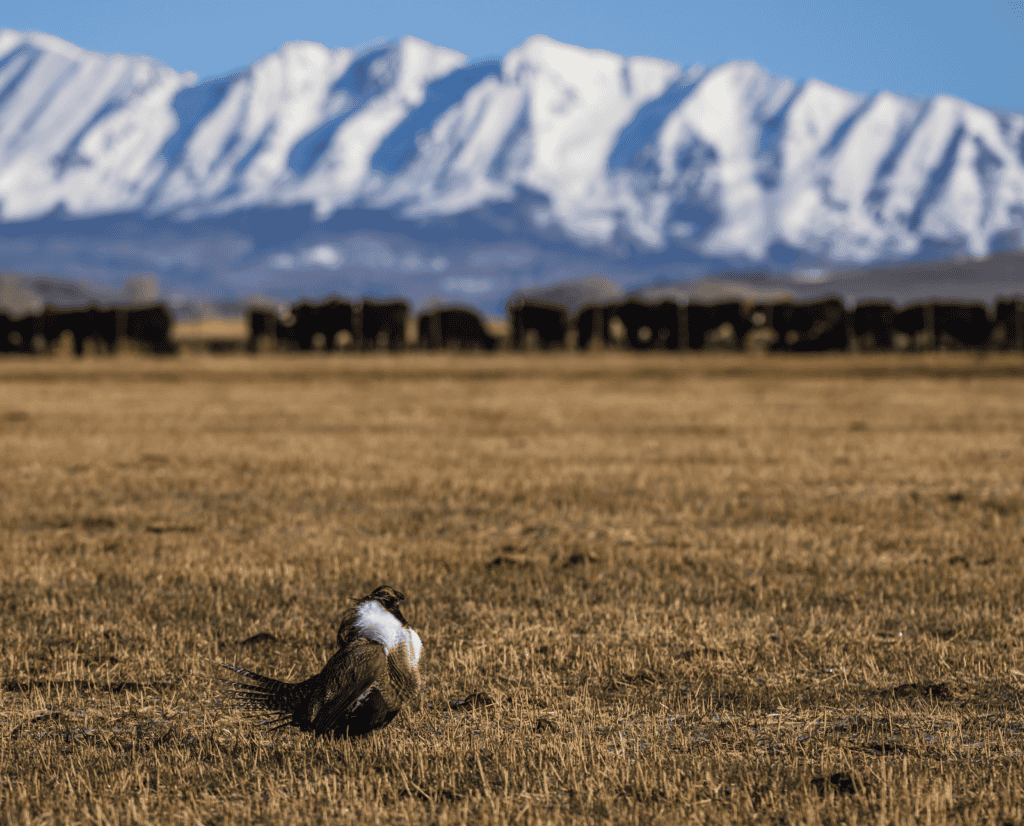Home » Public Lands » The Productive Public Lands Act Would Open Energy Development On Threatened Gunnison Sage-Grouse Habitat
The Productive Public Lands Act Would Open Energy Development On Threatened Gunnison Sage-Grouse Habitat

Gabby Zaldumbide is Project Upland's Editor in Chief. Gabby was…
An act introduced by Representative Jeff Hurd is a perfect example of D.C. politics creeping into state wildlife management.
U.S. Representative Jeff Hurd, a representative of Colorado’s 3rd District, recently introduced H.R. 1997: the Productive Public Lands Act. His office published a news release stating that the act would “unlock resource development on some of our most productive public lands.”
Rep. Hurd is quoted in the release. He stated, “This bill would force the Bureau of Land Management (BLM) to reissue nine Biden-era Resource Management Plans (RMPs), which locked up access to viable lands throughout Colorado and the West. A reissuance of these RMPs will put us on a path to energy dominance allowing for a more secure and prosperous United States.”
The Productive Public Lands Act would also affect plans in Montana, Oregon, and Wyoming. In Colorado, the BLM manages approximately 8.3 million surface acres and 27 million mineral acres. These areas are divided into ten separate Field Offices for planning and administrative purposes. Field Offices manage RMPs, which get approved through “the NEPA process,” or National Environmental Policy Act protocols that include public comment periods.
Through the NEPA process, the public has the rare opportunity to tell decision makers, “Hey, we care about these resources, and these are our concerns.”
When it comes to approved RMPs and amendments, the public has already spoken. So why would a U.S. representative go against the public who elected him to introduce a bill no one asked for?
What Are Resource Management Plans?
According to Rep. Hurd’s office’s press release, “This legislation would revisit the unreasonable restrictions imposed on our public lands by the Biden-Harris administration through the BLM and continue the process of unlocking our energy dominance in the West.” But the Biden Administration did not unreasonably restrict access to BLM lands because state and local governments, the public, and interested stakeholders are the ones heavily involved in the Resource Management Plan process.
“The Federal Land Use Policy and Management Act of 1976 (FLPMA) requires BLM to develop RMPs to guide decision making within each Field Office,” said Jon Holst, an attorney, biologist, and senior policy advisor with Western Resource Advocates. These plans are typically updated every 20 years. And when the BLM updates one, it is a big deal because RMP amendments must go through the NEPA process.
The NEPA Process
The lengthy NEPA process is often considered cumbersome. “It requires preparation of an Environmental Assessment or Environmental Impact Statement under the National Environmental Policy Act,” Holst continued. “NEPA also requires public notice and comment opportunities, and this is where the public gets involved.” During the NEPA process is the only time Americans have the opportunity to influence federal decision makers.
Additionally, the Bureau of Land Management must include state and local governments during its land use planning activities. RMPs reflect the priorities of those groups “to the extent possible while still adhering to BLM’s other mandates and responsibilities under FLPMA and federal law,” said Holst.
When the plans are finalized, they provide clarity and direction for all invested stakeholders. They allow us to lease, conserve, and utilize our public lands in manners consistent with the plan’s guidance. We may not always agree with how public lands are used, but the NEPA process is vital to ensuring all stakeholders have a voice in how said lands are managed.
Rescinding The Gunnison Sage-Grouse Amendment Would Threaten Their Existence
The Productive Public Lands Act seeks to rescind nine approved RMPs for multiple species. The list includes mule deer, elk, pronghorn, bighorn sheep, and the Gunnison sage grouse, a native grouse listed as threatened under the Endangered Species Act.
According to the National Audubon Society, the Gunnison sage grouse is one of the most endangered birds in North America. Less than 5,000 individuals exist. The 2025 State of the Birds Report listed the bird as a Red Alert Tipping Point Species, or a bird with “perilously low populations and steep declining trends.” Forty-three percent of them live on private lands, and 42 percent call Bureau of Land Management lands home.
The 2024 sage grouse RMP amendment (RMPA) brought the BLM into alignment with state and local efforts to prevent their extinction. The critical areas this grouse species needs to exist are the exact ones Rep. Jeff Hurd would like to open for development.

Local Reactions To Reissuing The Gunnison Sage-Grouse RMP Amendment
The Gunnison Basin Sage-Grouse Strategic Committee met on March 19, 2025. The Committee is a longstanding stakeholder group that works to protect this species. In the meeting, stakeholders discussed their reactions to the Productive Public Lands Act.
Gunnison County Commissioner Liz Smith recommended that the Committee consider writing a letter to Rep. Hurd outlining how the Gunnison sage grouse RMPA was a grassroots process. “The rhetoric has been about the Biden Administration locking up public lands, and it simply isn’t true,” she said.
PPLA Impacts To Gunnison Sage-Grouse
The Gunnison sage grouse RMP Amendment was approved in October 2024. The current language in the Productive Public Lands Act explains that Gunnison sage grouse RMPA would be reissued under a “no action alternative.” This would revert sage grouse regulations from the current management plan to a plan that was approved in 1998—before the Gunnison sage grouse was listed as a threatened species under the Endangered Species Act. In fact, the Gunnison sage grouse wasn’t even designated as a distinct species until the year 2000.
“Many of these plans don’t have any Gunnison sage grouse-specific regulations or stipulations,” said the Strategic Committee Chair, Kathy Griffin, when talking about the five BLM Field Offices with Gunnison sage grouse management plans.
“If the Productive Public Lands Act were enacted into law, the Gunnison Sage Grouse Resource Management Plan Amendment would cease to exist,” said Schafer. “The 1-mile buffers around lek sites, the Areas of Critical Environmental Concern, and overall habitat protections would largely be gone.”
If the PPLA becomes law, the recovery of this bird becomes even more unlikely. The 2024 amendment was largely geared towards improving habitat conditions for the vulnerable satellite populations of Gunnison sage-grouse. So far, some satellite population numbers have decreased, and others no longer exist.
“From an objective point of view, the Productive Public Lands Act does nothing but sow chaos. It ensures that our BLM lands will be managed under antiquated Resource Management Plans that will exacerbate conflicts between public lands users across the board,” said Schafer.
“When Representative Hurd was campaigning, he said that he values the perspective of people on the ground in our local communities,” Commissioner Smith said.
People In Colorado’s 3rd District Care About Gunnison Sage-Grouse
Gunnison sage-grouse are very sensitive to human disturbance. As a result, folks in Gunnison County, Colorado, and even federal agencies go out of their way to protect the grouse, especially during the breeding season.
Local restrictions on public land decrease human disturbances around lek sites. Depending on the location, some places close access before 10 a.m. and limit access through May 15. Others are completely closed to all human activity into July. Seasonal road closures and signage for breeding grouse on BLM land are commonplace, too. Even the Gunnison County Landfill changes their springtime hours of operation out of respect to a nearby lek.
Locally, everyone agrees that this bird is culturally and ecologically important. In fact, the RMP amendment only received five letters in protest. None of them were from the oil and gas industry, and all of them were concerned that the amendment didn’t go far enough to protect the bird.
“There is a process for protesting and appealing BLM’s final decision on these RMPs,” said Holst. “Throughout this official process, no oil and gas stakeholder protested any of the Colorado RMPs identified in the Productive Public Lands Act. To now revisit and second guess these decisions ignores literally thousands of hours of effort by BLM staff, cooperating agencies, and stakeholders who carefully developed a decision consistent with state and local policies and public desires.”
In short, the PPLA ignores local consensus and undermines the transparent, democratic process established by NEPA.

Natural Gas Development Is Market Driven
“The market dictates development, and the majority of development that occurs on BLM lands in western Colorado is natural gas development,” he continued. According to Schafer, the break-even price for natural gas in the West is significantly more than the break-even prices for gas coming from the Permian or Marcellus shale basins. “Oil and gas operators are not going to invest millions in development costs when they cannot make a profit.” In other words, it’s too expensive to drill here right now.
One of the alleged goals of Rep. Hurd’s PPLA is to open up lands for oil and gas leasing. However, the industry does not seem very interested in drilling here. “No oil and gas operator or industry association protested any of the RMPs included in Rep. Hurd’s bill, nor did any county commission,” Schafer said. Given that information, one can assume that the oil and gas industry was satisfied with the existing RMPs.
Colorado Sued The BLM Over RMPs in 2019
Resource Management Plans are meant to minimize and mitigate impacts to natural resources. This intention is so strong that the state of Colorado sued the Bureau of Land Management in 2019 after deeming the agency wasn’t doing enough for the state’s natural resources.
“The State of Colorado came to a legal settlement with the Department of Interior (DOI) over the Uncompahgre Field Office RMP,” said Schafer.
“This lawsuit followed an administrative protest filed by the Department of Natural Resources and Colorado Parks and Wildlife because the RMP revision did not provide adequate protections for sensitive habitats for big game and Gunnison sage-grouse. It could jeopardize the state’s ability to meet its management objectives for these species within the planning area,” said Holst.
In the settlement agreement, the DOI agreed to conduct a planning process to better protect big game habitat and Gunnison sage-grouse: the RMPAs. One amendment became the statewide Resource Management Plan Amendment for Big Game Habitat Conservation for Oil and Gas Management. The other is the Gunnison Sage-Grouse Resource Management Plan Amendment.
These RMPAs might as well no longer exist under the Productive Public Land Act.
“The lack of conservation management has long been a point of contention between the counties, state, and the BLM,” said Schafer. “In fact, the U.S. Fish and Wildlife Service Gunnison sage-grouse recovery plan specifically calls out improved federal land management and habitat conservation and restoration as a priority 1 action.”

What Is The Goal Of Introducing The Productive Public Lands Act?
In the press release, Chairman LaMalfa said, “Fortunately, a new era has dawned, and we have the opportunity to reverse these lockups and reinstate the multiple-use mandate on America’s public lands. The Productive Public Lands Act will open up the public’s land to be used for recreation, grazing, timber harvesting, drilling, mining, and other appropriate uses.”
But Bureau of Land Management lands with RMPs are not locked-up. They are not closed to multiple uses; I herd cattle on BLM land with Gunnison sage-grouse on it myself. Not only would Rep. Hurd’s bill imperil the Gunnison sage-grouse further, it also brings into question whose interests are being served by its introduction.
Whether we’re talking about public access or federal taxes paid on oil and gas, if the public does not benefit from this bill, then why was it introduced? What is the actual goal here? Is it all ideological, or just political posturing? Or is there a hidden interest group?
Is This Bill Washington-Driven?
Knowing that none of the public, the oil and gas industry, county commissioners, or the state of Colorado supported opening these lands to additional development, I can’t help but interpret this as D.C. drama leaking its way into western U.S. natural resource management. Unfortunately, this behavior is inconsistent with Rep. Hurd’s promises as a congressman.
“Coloradans enjoy robust wildlife populations, world class recreation opportunities, and all forms of energy development because our lands, water, and wildlife resource managers are amongst the best in the world,” said Schafer. “If we believe that decisions are best made by those living closest to the consequences of those decisions, then I don’t see how someone could see this bill from Washington D.C. as being appropriate.”
Take Action
If you decide to take action regarding the Productive Public Lands Act, there are a few things you can do. “Since is Rep. Hurd’s bill and there is no additional public process, the only avenue available is to contact his office, the office of any co-sponsors of this bill, and your representatives,” said Holst. “It would be nice for Rep. Hurd and the co-sponsors to hear loud and clear that this bill sidelines the voices of thousands of hunters, anglers, and average people who use and love these lands.”
We are living in a time where moderate Republicans seem to be an endangered species in their own right. Let’s encourage our representatives that it’s okay to lean more towards the middle of the aisle and perhaps cater less to the ideologies of the extremes. Let’s continue to use the most up-to-date information, not greed, to manage our public lands and wildlife, including bird species at risk of extinction.
Gabby Zaldumbide is Project Upland's Editor in Chief. Gabby was born in Maryland and raised in southern Wisconsin, where she also studied wildlife ecology at the University of Wisconsin-Madison. In 2018, she moved to Gunnison, Colorado to earn her master's in public land management from Western Colorado University. Gabby still lives there today and shares 11 acres with eight dogs, five horses, and three cats. She herds cows for a local rancher on the side.




If you have a bill # I would appreciate knowing it so I could call \write my congressman. Thanks
It is H.R. 1997.
Do you know if BHA is preparing a letter for HR 1997, that sends it to appropriate parties digitally? Many thanks for all you do for our resources!
That is a great question! I am not sure. I’d reach out to your state chapter’s leaders!
“In short, the PPLA ignores local consensus and undermines the transparent, democratic process established by NEPA.”
This is 100% driven by the new administration’s mission of profit over public opinion. If there’s money, power or position to be gained they simply do not care what the citizens think. Even the title, “Productive Public Lands Act, is meant to deceive.
You’re getting your shorts in a bunch over nothing .
Wind farms and solar farms that the democrats pushed are 1000% worse than anything that may happen under this legislation .
Did anyone in any article on this website have anything positive to say about wind and solar development on public lands? You must be upset about some other brand. We don’t care what party any politician belongs to. If you come for our public lands—critical habitat for birds like the Gunnison Sage-Grouse—we’re going to speak out. No wealthy politician in this country is a true friend to working-class folks like the people who follow and work at Project Upland.